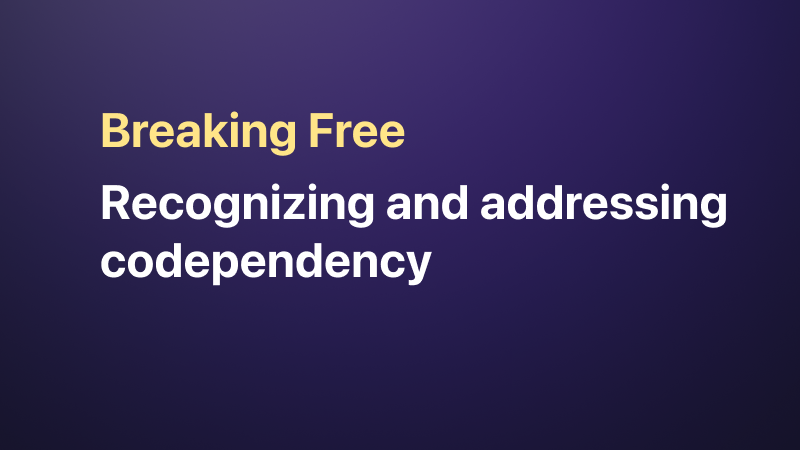Relationships are meant to be a beautiful balance of two people bringing out the best in each other. But sometimes, that balance tilts, and before you know it, you’re not just leaning on each other—you’re tangled up like earbuds in a pocket. Welcome to the world of codependency: a place where boundaries blur, self-worth gets tied to someone else, and “together” feels like the only option. But don’t worry—breaking free doesn’t mean breaking up. It’s about finding that sweet spot where you can be together and still stand strong on your own.
1. What Exactly Is Codependency? (And No, It’s Not Just Needing Your Partner)
Codependency is like having two lives that are so intertwined that it’s hard to tell where one person ends and the other begins. It’s more than just relying on each other; it’s when one person’s needs, moods, and happiness become the sun around which the other’s world revolves. Think of it as being the emotional version of that friend who can’t decide where to eat until you do. It feels like closeness, but in reality, it’s just a tangle of over-reliance, blurred boundaries, and a lack of individual space.
2. Signs You Might Be Dancing the Codependency Tango
- You’re always the fixer: If their problems feel like your problems and you’re always swooping in to save the day, that’s a red flag.
- Your mood depends on their mood: If they’re having a bad day, your day’s ruined too. It’s like your emotional thermostat is set by them.
- You lose yourself in the relationship: Hobbies? Friends? Those things start to slip away as you pour everything into your partner.
- You struggle with saying no: Your needs often take a backseat because you’re afraid of rocking the boat.
- Validation vacuum: You constantly seek approval from your partner, like an emotional Wi-Fi connection that you can’t bear to lose.
3. Breaking the Cycle: How to Address Codependency
Recognizing codependency is the first step—kind of like finding the knot in that earbuds tangle. Now it’s time to loosen it up and start finding some space.
Find Your ‘You’ Time
Start carving out moments that are just for you. Whether it’s picking up an old hobby, hanging out with friends, or just enjoying a quiet moment with a book, reclaiming solo time is crucial. It’s about rediscovering what makes you, well… you.
Set Boundaries (And No, They’re Not Barriers)
Boundaries are the guardrails of a healthy relationship. They’re not about pushing your partner away—they’re about keeping your sense of self intact. Practice saying no when something doesn’t feel right, and be clear about what you need from your partner. It’s not selfish; it’s necessary.
Stop Playing the Rescuer
You’re not your partner’s therapist, parent, or superhero. It’s okay to offer support, but it’s also okay to let them handle their own stuff. Encourage them, cheer them on, but let them navigate their own challenges. After all, they’re capable, and you both need room to grow.
Check in with Yourself Regularly
Make it a habit to ask yourself how you’re feeling—not just about the relationship, but about your own life. Are you happy? Are your needs being met? This kind of self-awareness helps you stay grounded and prevents you from losing yourself.
Seek Out Support If You Need It
Sometimes, untangling codependency requires a little extra help. Don’t hesitate to talk to a coach, therapist, or join a support group. Getting an outside perspective can give you the tools you need to rebuild a healthy, interdependent relationship.
4. Building Healthy Interdependence
Healthy relationships are all about interdependence, where two whole people come together to support each other without losing themselves in the process. It’s about mutual respect, open communication, and a strong sense of self. Here’s the kicker: you can love someone deeply and still be your own person. The goal isn’t to drift apart; it’s to grow stronger, side by side.
Self-Reflection Question:
- What’s one thing I can do today that’s just for me, without involving my partner?
Quiz: Are You on the Path to Healthy Interdependence?
-
Do you feel anxious when your partner is upset, even if it’s not about you?
- A) Always
- B) Sometimes
- C) Rarely
-
How often do you set aside time for your own interests or hobbies?
- A) Hardly ever
- B) Occasionally
- C) Often
-
When your partner faces a problem, what’s your first instinct?
- A) Jump in and fix it
- B) Offer advice but let them handle it
- C) Listen and support, but trust they can manage
Results:
- Mostly A’s: It’s time to put the brakes on the rescue missions and rediscover your own space. You’ve got this!
- Mostly B’s: You’re finding a balance, but a little more focus on yourself wouldn’t hurt.
- Mostly C’s: You’re on the path to healthy interdependence—keep nurturing that sense of self.
Recognizing codependency is the first step to breaking free. It’s not about cutting ties but finding a balance that lets both of you thrive individually and together. Embrace your individuality, set those boundaries, and watch your relationship grow stronger and healthier.




